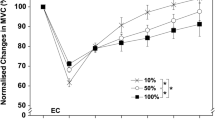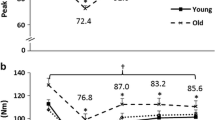Abstract
A bout of eccentric exercise confers protection against subsequent bouts of the same exercise. This study investigated whether the protective effect would be produced similarly between old and young adults. Eight old men (70.5 ± 4.1 years) and ten young men (20.4 ± 2.0 years) performed two bouts of eccentric exercise of the elbow flexors (six sets of five eccentric actions) separated by 4 weeks. Changes in maximal isometric strength, range of motion (ROM), upper arm circumference (CIR), plasma creatine kinase (CK) activity, myoglobin (Mb) concentration, and muscle soreness (SOR) before, immediately after, and 1, 24, 48, 72 and 96 h following exercise were compared between bouts, and between groups by a two-way repeated measures ANOVA. Changes in the measures following the first bout were significantly (P < 0.05) smaller for the old than the young group. The young group showed significantly (P < 0.05) smaller changes in all measures following the second bout than the first bout; however, the old group had the protective effect only for ROM, Mb, and SOR. The magnitude of the effect observed for ROM and Mb concentration in the old group was significantly (P < 0.05) smaller compared with that of the young group. These results suggest that the protective effect conferred by the first bout was less for the old than the young group. This may be due to the less muscle damage after the first bout in the old subjects, but it is also possible that the protective effect of old adults does not last as long as that of young adults.



Similar content being viewed by others
References
Chen T (2003) Effects of a second bout of maximal eccentric exercise on muscle damage and electromyographic activity. Eur J Appl Physiol 89:115–121
Clarkson PM, Dedrick ME (1988) Exercise-induced muscle damage, repair and adaptation in old and young subjects. J Gerontol 43:M91–M96
Clarkson PM, Hubal MJ (2001) Are women less susceptible to exercise-induced muscle damage? Curr Opin Clin Nutr Metab Care 4:527–531
Clarkson PM, Tremblay I (1988) Exercise-induced muscle damage, repair, and adaptaion in humans. J Appl Physiol 65:1–6
Clarkson PM, Nosaka K, Braun B (1992) Muscle function after exercise-induced muscle damage and rapid adaptation. Med Sci Sports Exerc 24:512–520
Dedrick ME, Clarkson PM (1990) The effects of eccentric exercise on motor performance in young and older women. Eur J Appl Physiol 60:183–186
Ebbeling CB, Clarkson PM (1990) Muscle adaptation prior to recovery following eccentric exercise. Eur J Appl Physiol 60:26–31
Frontera WR, Hughes VA, Dallal GE, Evans WJ (1993) Reliability of isokinetic muscle strength testing in 45- to 78-year old men and women. Arch Phys Med Rehabil 74:1181–1185
Hamada K, Vannier E, Sacheck LM, Witsell AL, Roubenoff R (2005) Senescence of human skeletal muscle impairs the local inflammatory cytokine response to acute eccentric exercise. FASEB J 19:264–266
Hirose L, Nosaka K, Newton M, Lavender A, Kano M, Peake J, Suzuki K (2004) Changes in inflammatory mediators following eccentric exercise of the elbow flexors. Exerc Immunol Rev 10:75–90
Jones DA, Newham DJ, Round JM, Tolfree SEJ (1986) Experimental human muscle damage: morphological changes in relation to other indices of damage. J Physiol 375:435–448
Klein CS, Rice CL, Marsh GD (2001) Nomalized force, activation, and coactivation in the arm muscles of young and old men. J Appl Physiol 91:1341–1349
Klein CS, Marsh GD, Petrella RJ, Rice CL (2003) Muscle fiber number in the biceps brachii muscle of young and old men. Muscle Nerve 28:62–68
Lavender AP, Nosaka K. (2006) Comparison of changes in markers of muscle damage between old and young men following voluntary eccentric exercise of the elbow flexors. Appl Physiol Nutr Metab 31:1–8
Lemmer JT, Hurlbut DE, Martel GF, Tracy BL, Ivey FM, Metter EJ, Fozard JL, Fleg JL, Hurley BF (2000) Age and gender responses to strength training and detraining. Med Sci Sports Exerc 32:1505–1512
Macaluso A, De Vito G. (2004) Muscle strength, power and adaptations to resistance training in older people. Eur J Appl Physiol 91:450–472
Manfredi TG, Fielding RA, O’Reilly KP, Meredith CN, Lee HY, Evans WJ (1991) Plasma creatine kinase activity and exercise-induced muscle damage in older men. Med Sci Sports Exerc 23:1028–1034
McHugh MP (2003) Recent advances in the understanding of the repeated bout effect: the protective effect against muscle damage from a single bout of eccentric exercise. Scand J Med Sci Sports 13:88–97
Monemi M, Eriksson P-O, Eriksson A, Thornell L-E. (1998) Adverse changes in fiber type composition of the human masseter versus biceps brachii muscle during aging. J Neurol Sci 154:35–48
Nosaka K, Newton M (2002) Difference in the magnitude of muscle damage between maximal and submaximal eccentric loading. J Strength Cond Res 16:202–208
Nosaka K, Sakamoto K, Newton M, Sacco P (2001a) The repeated bout effect of reduced-load eccentric exercise on elbow flexor muscle damage. Eur J Appl Physiol 85:34–40
Nosaka K, Sakamoto K, Newton M, Sacco P (2001b) How long does the protective effect on eccentric exercise-induced muscle damage last? Med Sci Sports Exerc 33:1490–1495
Nosaka K, Newton M, Sacco P, Chapman D, Lavender A (2005) Partial protection against muscle damage by eccentric actions at short muscle lengths. Med Sci Sports Exerc 37:746–753
Ploutz-Snyder LL, Giamis EL, Formikell M, Rosenbaum AE (2001) Resistance training reduces susceptibility to eccentric exercise-induced muscle dysfunction in older women. J Gerontol 56:B384–B390
Roth SM, Martel GF, Ivey FM, Lemmer JT, Metter EJ, Hurley BF, Rogers MA (1999) Ultrastructural muscle damage in young vs. older men after high-volume, heavy-resistance strength training. J Appl Physiol 86:1833–1840
Roth SM, Martel GF, Ivey FM, Lemmer JT, Tracy BL, Hurlbut DE, Metter EJ, Hurley BF, Rogers MA (2000) High-volume, heavy-resistance strength training and muscle damage in young and older women. J Appl Physiol 88:1112–1118
Symons TB, Vandervoot AA, Rice CL, Overend TJ, Marsh GD (2005) Reliability of a single-session isokinetic and isometric strength measurement protocol in older men. J Gerontol A Biol Sci Med Sci 60:114–119
Tiidus PM (2000) Estrogen and gender effects on muscle damage, inflammation, and oxidative stress. Can J Appl Physiol 25:274–287
Warren GL, Ingalls CP, Lowe DA, Armstrong RB (1999) What mechanisms contribute to the strength loss that occurs during and in the recovery from skeletal muscle injury? J Orthop Sports Phys Ther 32:58–64
Author information
Authors and Affiliations
Corresponding author
Rights and permissions
About this article
Cite this article
Lavender, A.P., Nosaka, K. Responses of old men to repeated bouts of eccentric exercise of the elbow flexors in comparison with young men. Eur J Appl Physiol 97, 619–626 (2006). https://doi.org/10.1007/s00421-006-0224-7
Accepted:
Published:
Issue Date:
DOI: https://doi.org/10.1007/s00421-006-0224-7




